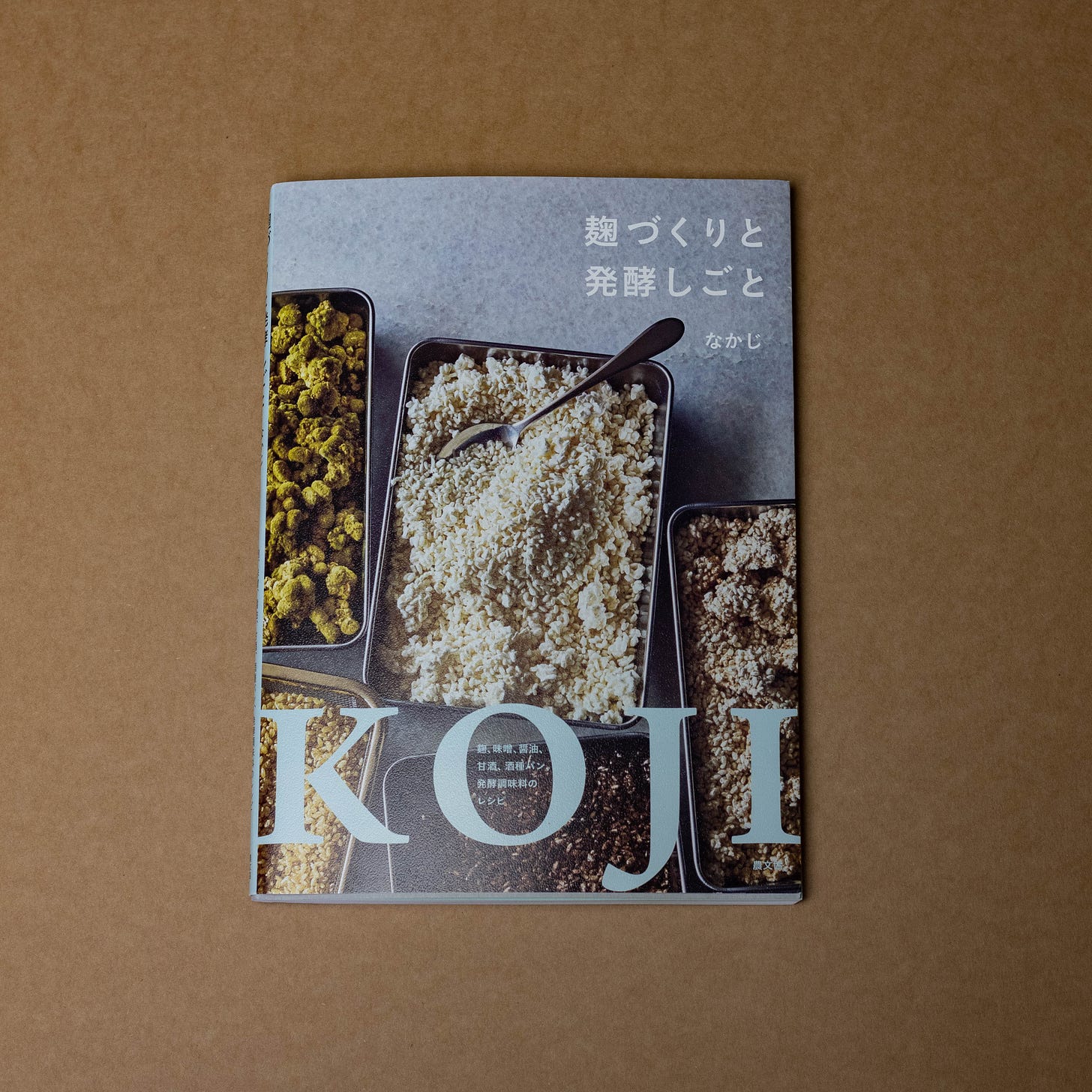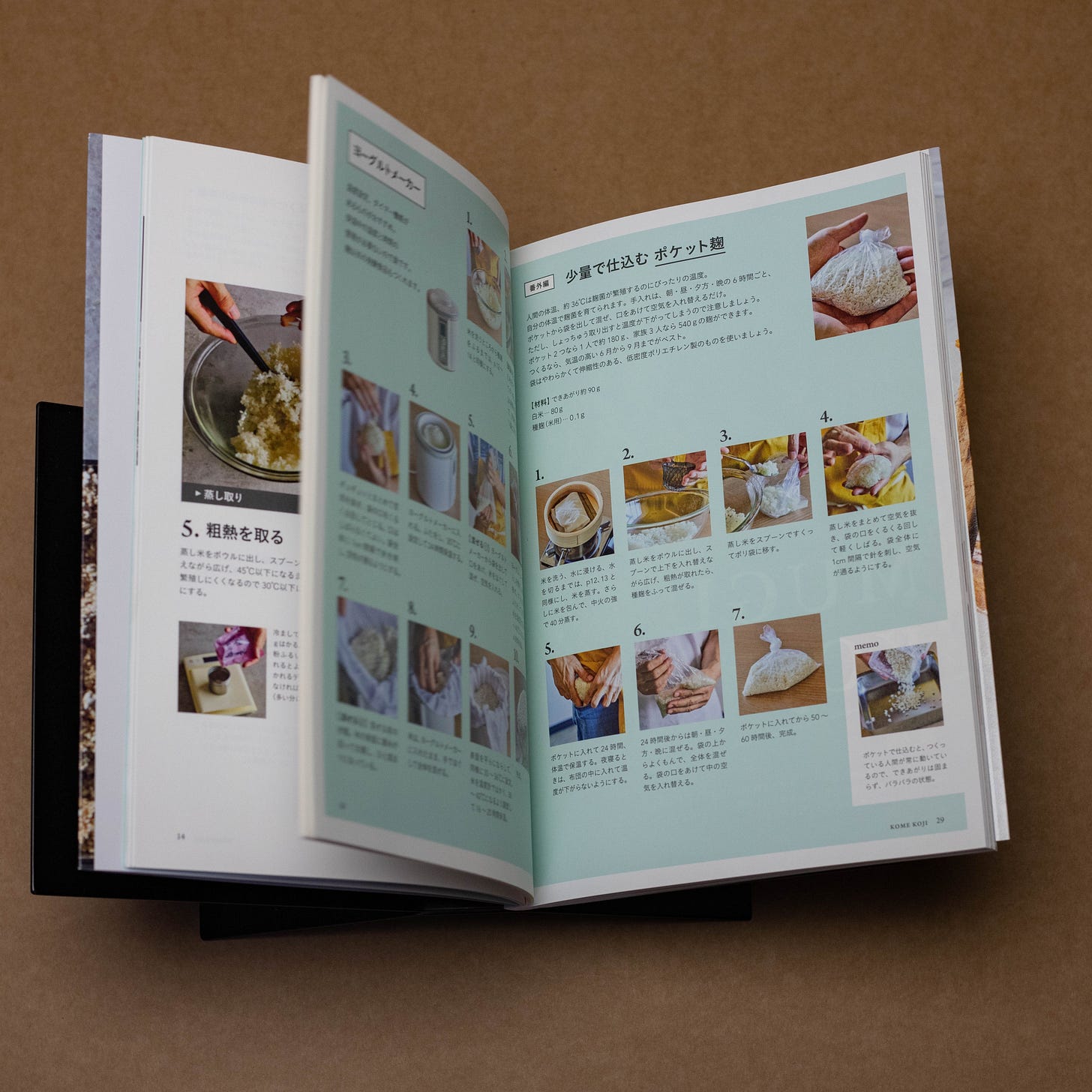If I Had to Recommend One Beginner Koji Book, It’d Be Nakaji Minami’s 麹づくりと発酵しごと
A beautifully practical guide for anyone ready to dive into the art of koji-making
For anyone venturing into the world of koji fermentation, you’ve probably heard the same two names tossed around: Marika Groen’s Cozy Koji and Nakaji Minami’s Koji for Life. Both are excellent beginner-friendly resources. But if you’ve mastered the basics and want a book to help you go deeper — or if you’re a total newbie with the ambition to dive headfirst into the craft — Nakaji Minami’s second book, 麹づくりと発酵しごと (Koji-Making and Fermentation Work), might just be the one.
While this book is currently only available in Japanese, don’t let that stop you — the pictures alone are worth the price. Even if you’re not fluent, it’s easy to follow along, thanks to the clear step-by-step instructions and stunning visuals. It’s the ultimate starter pack for anyone wanting to dive into koji, offering just the right mix of inspiration, guidance, and practical know-how to get you started and running.
What Makes It Special
Minami doesn’t just tell you how to make koji — he shows you. The detailed, step-by-step photos are one of the book’s biggest strengths, walking you through processes for rice koji, sour white and black koji, barley, shoyu, and even brown rice koji. Fermentation is a deeply sensory experience, and while a book can’t offer smells or tastes, Minami makes up for it by providing clear visual cues and instructions to guide you. Each chapter is concise, intuitive, and thoughtfully designed with color cues to split up sections, so you’ll feel confident following along, no matter your experience level.
I also love how Minami lowers the barrier to entry by emphasizing tools and methods accessible to most Japanese households. You don’t need a professional incubator or a ton of specialized gear to get started. All you need is a clean plastic bag, rice, spores, and a pocket to tuck your rice-filled bag in for warmth. And yes, I’ve tried it — it works!
The book doesn’t stop at methods. It includes “key recipes” in the back for each type of koji, highlighting Minami’s favorite ways to use them. These recipes range from simple applications to more ambitious projects, giving you something to strive for once you’ve mastered the basics.
Finally, the size of the book deserves a mention. It’s compact but dense, packed with enough information to keep you experimenting for months. Minami has managed to create a beginner’s guide that feels anything but basic.
A Few Challenges
No book is perfect, and 麹づくりと発酵しごと has its quirks.
For one, the constant references to other pages, footnotes and sections can be a bit distracting, particularly if you’re using a Kindle where flipping back and forth isn’t as easy.
The other notable gap is the lack of “why.” Minami doesn’t dive into the science behind his methods. Why start with 300g of rice? (My guess: it fits comfortably in the tools he recommends, but it’s not explicitly stated.) Why raise the temperature to 38–42°C during certain types of koji fermentation, only to lower it again in the final hours? If you’re the curious type — and let’s face it, fermentation tends to attract the curious — you’ll find yourself asking these questions.
To be fair, this book isn’t trying to demystify the science of koji. It’s a how-to, not a “why-so.” If you’re the kind of person who needs to know why things work, you’ll want to dig into other resources — and that’s exactly where The Koji Collection plans to step in.
Why I Bought It
I’ll admit, I’m a sucker for koji books — if it’s about koji, it’s probably already on my [virtual] shelf. But this one had me especially excited because I loved the aesthetics and clarity of Minami’s previous work. Beyond that, I’ve been eager to explore making bread with koji and natural yeast, a topic he explores here in depth.
What I love most about this book is how it moves beyond shio koji basics to showcase a more modern and inventive side of koji-making. Minami’s approachable methods and clear, thoughtful documentation have set the standards and been an inspiration for The Koji Collection books.
While I don’t know if we’ll ever match the stunning photography in his books, I hope we can address some of the gaps, like those pesky “why” questions, to make the art of koji-making even more accessible.
Final Thoughts
Whether you’re a total beginner or someone looking to expand your koji repertoire, 麹づくりと発酵しごと is a fantastic resource. Equal parts inspiring and practical, it’s the kind of book you’ll keep coming back to as you dive deeper into the endless possibilities of koji. Approach it like a cookbook: start by following the recipes and pictures exactly as shown. Once you’ve mastered the process, the real fun begins—experimenting, innovating, and uncovering the “why” behind the “how.” That’s where The Koji Collection comes in to guide your next steps. If you can get your hands on this book, don’t hesitate—it’s a worthy addition to any fermentation library.
Max Graze
Book Details
Author: Nakaji Minami
Print length: 96 pages
Language: Japanese
Publication date: November 14, 2024
Table of Contents
(translated from Japanese)
Introduction
Basic materials and tools
Rice Koji (Kome Koji)
Making rice koji
Making rice koji (large quantities)
Chinese steamer/stainless steel steamer
Ziplock plastic bag
Glass bowl
Yogurt maker
Extra: Pocket koji for small quantities
Barley malt (Mugi Koji)
Making barley koji
About Koji Mold
Three types of koji molds essential for Japanese fermented foods
Black Koji and White Koji (Kuro Koji · Shiro Koji)
Making black and white koji
The Story of Koji
A fungus cultivated and selected over a long history
Brown rice malt (Genmai Koji)
Making brown rice koji
Soy sauce koji (Shoyu Koji)
Making soy sauce koji
About Koji Mold
How to use the ever-evolving koji mold
Making soy sauce
The difference between artisanal soy sauce and raw soy sauce
Various uses for Koji
Making sake yeast bread
Step 1: Brewing sake yeast and soyashi water/main brewing
Step 2: Sake yeast bread
Making miso
Sweet miso
Brown rice miso/barley miso
Making Amazake
Sweet rice sake
Black Koji Amazake, White Koji Amazake, Brown Rice Amazake
Sea bream sushi
Salted sweet sake pickled egg yolk rice / Yuzu-scented koji natto
Dried squid marinated in sweet sake / Fermented takara-zuke
Making soy sauce using sweet sake
Sweet sake peperon sauce / Umami miso gochujang / Sweet sake mala sauce
Garlic toast salad / Peperoncino
Tomato spicy tofu / Cucumber and chicken with spicy sauce
Boiled pork with gochujang / Bean sprout namul / Gochujang rice ball
Making fermented seasonings
Soy sauce koji / Onion koji / White koji ponzu
Making dashi soy sauce
Dashi soy sauce
Tomatoes simmered in soy sauce / Lightly pickled avocado
Lightly pickled cucumber / Tuna and egg yolk rice bowl
The Story of Koji
The Koji Tane Shop that Protects Japanese Food Culture
Where to get tane koji
Koji making Q&A
Conclusion






Thank you for the review of Koji. Any idea when it'll be translated into English?